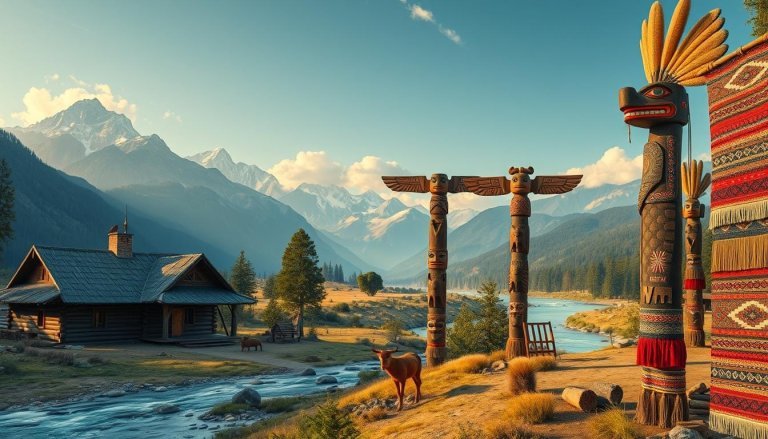Exploring USA indigenous cultures is like diving into a world of history and traditions. There are 567 federally recognized tribes. Native American and Alaska Native peoples make up about 2% of the U.S. population.
California has the most Native people, and New York City has the most Native residents. This shows the diversity of Native American tribes.
Indigenous Peoples’ Day is on the second Monday of October. It’s a great time to learn about Native American tribes. You can find learning opportunities in cities and reservations.
Did you know 23% of Native Americans live in Native areas or Alaska Native villages? These places are like living museums. They keep ancient customs and languages alive.
But, there are challenges. The poverty rate for Native Americans is around 27%. This shows the struggles they face.
Yet, many tribes are fighting to keep their heritage alive. The Cherokee Freedmen got their citizenship back. Kiowa, Apache, and Comanche landowners won a big legal fight against a gas pipeline company.
These victories show the strength and resilience of Native peoples. Are you ready to learn about indigenous cultures in the USA? We’ll find the best places, from museums to tribal lands.
Understanding USA Indigenous Cultures and Their Historical Significance
The rich tapestry of Native American heritage in the United States is as diverse as it is profound. With an estimated 6.6 million people identifying as Native American or Alaska Native, these cultures have left an indelible mark on the nation’s history and continue to shape its present.
Demographics and Distribution of Native American Populations
Native American populations are spread across the USA, with about 23% residing in Native American areas or Alaska Native villages. Historical estimates suggest pre-Columbian populations north of the Rio Grande ranged from 900,000 to 18 million. Today, these communities preserve their unique identities while adapting to modern life.
Federal Recognition and Tribal Sovereignty
Federal recognition grants tribes sovereign status, allowing them to govern themselves to a certain extent. This recognition is crucial for preserving indigenous languages and tribal customs. Recently, steps have been taken to address historical injustices, including President Biden’s apology for the 150-year Indian boarding school policy.
Cultural Heritage and Traditional Practices
Native American cultures are renowned for their rich traditions in indigenous art, storytelling, and tribal ceremonies. These peoples domesticated various plants and animals, including corn, beans, squash, and turkeys. Traditional practices encompass fire-making, stone tool creation, and crafts like basketry and pottery.
- Over 300 indigenous languages were spoken at the time of European contact
- Native Americans developed sophisticated agricultural techniques
- Tribal customs vary widely across different Native American nations
Despite historical challenges, many tribes actively work to preserve their cultural heritage. This includes efforts to revitalize indigenous languages, maintain tribal ceremonies, and pass down traditional knowledge to younger generations. The resilience of Native American cultures continues to enrich the diverse cultural landscape of the United States.
Notable Cultural Centers and Museums for Indigenous Learning
Across the USA, many places offer deep dives into indigenous knowledge and Native American arts. These spots are key for keeping cultures alive and sharing tribal stories. Here are some top places to learn more about Native American cultures.
National Museums and Cultural Institutions
The National Museum of the American Indian is a standout. It has a Native Knowledge 360° program. This program offers educational materials and virtual events for everyone.
In Washington, DC, the Smithsonian Folklife Festival highlights Indigenous voices. It shows dance, music, sports, and food from different Native cultures.
Tribal Museums and Heritage Sites
The Akwesasne Library and Cultural Center in New York is a Mohawk culture hub. In the Adirondacks, the Six Nations Iroquois Cultural Center has over 3,000 artifacts from the Haudenosaunee Confederacy.
The Seneca Art & Culture Center at Ganondagan shares Seneca art and culture. The Iroquois Museum in New York uses artwork to teach about the Iroquois.
Interactive Educational Facilities
Many places offer hands-on learning. The Native American Museum Studies Institute (NAMSI) offers free training on topics like Collections Management and Conservation. It will start again in 2024 after a break.
Some museums show living traditions. For example, the Wampanoag people’s Cranberry Day celebrations. Visitors can see these ongoing cultural practices.



